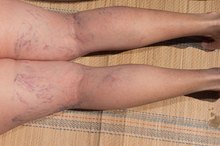What Are The Symptoms of Blood Clots in The Leg?
Symptoms of blood clot in the legs, also known as deep vein thrombosis (DVT) are important to understand to know when to seek treatment. DVT occurs in the deep veins. A superficial clot in the leg vein is known as thrombophletbitis. If a deep vein thrombosis in the lower leg or thigh becomes dislodged, it can travel to the lungs, brain or kidney, leading to cardiac arrest or organ damage.
Swelling
Swelling in one or both legs are symptoms of a blood clot. Swelling that is a symptom of a blood clot in the leg can be sudden or chronic. A blood clot in the leg might produce no symptoms at all unless the clot dislodges and travels to another part of the body and blocks blood flow. A blood clot that travels through the leg veins to the lungs can kill within a matter of hours, warns the American Academy of Orthopedic Surgeons. The most common sites of blood clots in the deep veins are in the thigh and calf area. The swelling comes from blood that pools below the clot. A clot is also known as a thrombus.
- Swelling in one or both legs are symptoms of a blood clot.
- A blood clot that travels through the leg veins to the lungs can kill within a matter of hours, warns the American Academy of Orthopedic Surgeons.
Foot Discomfort
Symptoms of a Blood Clot in Groin Area
Learn More
Foot pain is a possible symptom of blood clot in the leg. When blood flow is obstructed or slowed, the tissues no longer get enough oxygen from blood. The result is pain. Individuals with atherosclerosis (hardening of the arteries) are at increased risk for developing clots in the legs, as are individuals with varicose veins.
- Foot pain is a possible symptom of blood clot in the leg.
- When blood flow is obstructed or slowed, the tissues no longer get enough oxygen from blood.
Calf Pain
Pain in the calf area, especially with walking could indicate that a blood clot has developed in the leg. If you've been sitting for prolonged periods followed by any of the symptoms associated with DVT, get a diagnosis to rule out a blood clot that could result in dire health consequences if left untreated. Pain in the calf is notable when flexing the foot.
- Pain in the calf area, especially with walking could indicate that a blood clot has developed in the leg.
Skin Redness and Warmth
DVT Symptoms in the Legs
Learn More
The skin in the area where the clot forms in the thigh or calf can appear red. The skin might be warm to the touch, making it easy to confuse a blood clot in the leg with infection or injury.
Low-Grade Fever
The presence of a blood clot on the leg causes inflammation that could produce a low-grade fever. Fever is not always present when a blood clot develops in the leg. When fever is present, it is usually less than 101 degrees F. Fever is not specific for the presence of DVT, explained in a study published June 2000 and indexed at PubMed.gov 3.
Discoloration of the Extremity
The ankle and foot area can appear pale and can be a symptom of a blood clot or DVT in the leg. The foot will appear pale in comparison to the unaffected leg. Decreased blood flow that causes foot pallor also makes the foot feel cooler to the touch. Left untreated, a bluish discoloration and decreasing skin warmth to touch indicates that blood flow from a blood clot in the leg has become worse. DVT is a serious problem that requires immediate diagnosis and treatment.
- The ankle and foot area can appear pale and can be a symptom of a blood clot or DVT in the leg.
Related Articles
References
- FamilyDoctor.org: DVT Risks, Symptoms, Testing and Treatment
- Your Orthopedic Connection: Surgery and Deep Vein Thrombosis Risk
- PubMed: Fever and DVT
- American Society of Hematology. Blood Clots.
- Litvinov RI, Weisel JW. What Is the Biological and Clinical Relevance of Fibrin?. Semin Thromb Hemost. 2016;42(4):333-43. doi:10.1055/s-0036-1571342
- American Heart Association. Understand Your Risk for Excessive Blood Clotting.
- Adivitiya, Khasa YP. The evolution of recombinant thrombolytics: Current status and future directions. Bioengineered. 2017;8(4):331-358. doi:10.1080/21655979.2016.1229718
- Fields JM, Davis J, Girson L, et al. Transthoracic Echocardiography For Diagnosing Pulmonary Embolism: A Systematic Review And Meta-Analysis. J Am Soc Echocardiogr 2017; 30:714. doi:10.1016/j.echo.2017.03.004
- Gibson NS, Schellong SM, Kheir DY, et al. Safety And Sensitivity Of Two Ultrasound Strategies In Patients With Clinically Suspected Deep Venous Thrombosis: A Prospective Management Study. J Thromb Haemost 2009; 7:2035. doi:10.1111/j.1538-7836.2009.03635.x
- National Blood Clot Alliance. Signs and Symptoms of Blood Clots.
- Weitz JI, Fredenburgh JC, Eikelboom JW. A Test In Context: D-Dimer. J Am Coll Cardiol 2017; 70:2411. doi:10.1016/j.jacc.2017.09.024
Writer Bio
Kathleen Blanchard is a registered nurse, with more than 10 years of experience in cardiovascular health, emergency room and ICU. She writes professionally for Emaxhealth.com. and AskMen.com. Blanchard is currently employed as a senior case manager and has held certification as a critical care registered nurse (CCRN), advanced trauma life support (ATLS), and advanced cardiac life support (ACLS).








